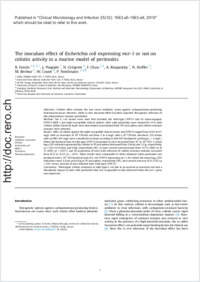The inoculum effect of Escherichia coli expressing mcr-1 or not on colistin activity in a murine model of peritonitis
- Fantin, B. IAME, INSERM UMR 1137, F-75018, Paris, France - Université Paris Diderot, Sorbonne Paris Cité, F-75018, Paris, France - AP-HP, Groupe Hospitalier Paris Nord Val de Seine, Service de médecine interne, F-92210, Clichy, France
- Poujade, J. IAME, INSERM UMR 1137, F-75018, Paris, France
- Grégoire, N. University of Poitiers, School of Medicine and Pharmacy, INSERM UMR1070, France
- Chau, F. IAME, INSERM UMR 1137, F-75018, Paris, France - Université Paris Diderot, Sorbonne Paris Cité, F-75018, Paris, France
- Roujansky, A. IAME, INSERM UMR 1137, F-75018, Paris, France
- Kieffer, Nicolas Emerging Antibiotic Resistance Unit, Medical and Molecular Microbiology, Department of Medicine, INSERM European Unit (LEA, IAME), University of Fribourg, Switzerland
- Berleur, M. IAME, INSERM UMR 1137, F-75018, Paris, France
- Couet, W. University of Poitiers, School of Medicine and Pharmacy, INSERM UMR1070, France
- Nordmann, Patrice IAME, INSERM UMR 1137, F-75018, Paris, France - Emerging Antibiotic Resistance Unit, Medical and Molecular Microbiology, Department of Medicine, INSERM European Unit (LEA, IAME), University of Fribourg, Switzerland - University Hospital and University of Lausanne, Lausanne, Switzerland
-
05.09.2019
Published in:
- Clinical Microbiology and Infection. - 2019, vol. 25, no. 12, p. 1563.e5-1563.e8
English
Colistin often remains the last resort antibiotic active against carbapenemase- producing Enterobacteriaceae. However, while in vitro inoculum effect has been reported, therapeutic relevance of this phenomenon remains questioned.Methods: Ten E. coli strains were used that included the wild-type CFT073 and its transconjugant CFT073-MCR-1 and eight susceptible clinical isolates. Mice with peritonitis were treated for 24 h with colistin sulfate. Bacterial loads were determined in peritoneal fluid (PF) and spleen and colistin-resistant mutants were detected.Results: MICs of colistin against the eight susceptible clinical strains and CFT073 ranged from 0.125 to 0.5 mg/L with an inoculum of 105 CFU/mL and from 2 to 4 mg/L with a 107 CFU/mL inoculum; 5/9 strains with an MIC of 4 mg/L were considered resistant according to EUCAST breakpoint (resistance, > 2 mg/L). When the bacterial load of wild-type CFT073 inoculated in mice increased from 107 to 108 CFU: i) mean log10 CFU reduction generated by colistin in PF and spleen decreased from 5.8/mL and 3.1/g, respectively, (p < 0.01) to 0.9/mL and 0.8/g, respectively (NS); ii) mice survival rate decreased from 15/15 (100%) to 6/15 (40%) (p = 0.017); and iii) proportion of mice with selection of colistin-resistant mutants increased from 4/15 to 15/15 (p < 0.01). These results were comparable to those obtained when peritonitis was produced with a 107 CFU bacterial load of E. coli CFT073 expressing mcr-1, for which the mean log10 CFU reductions were 3.5/mL and 0.6/g in PF and spleen, respectively (NS), and survival rate was 8/15 (53%) (p < 0.01 versus survival of mice infected with wild-type CFT073).Conclusions: Phenotypic colistin resistance in wild- type E. coli due to an increase in inoculum size had a therapeutic impact in mice with peritonitis that was comparable to that observed when the mcr-1 gene was expressed.
- Faculty
- Faculté des sciences et de médecine
- Department
- Médecine 3ème année
- Language
-
- English
- Classification
- Biological sciences
- License
-
License undefined
- Identifiers
-
- RERO DOC 328027
- DOI 10.1016/j.cmi.2019.08.021
- Persistent URL
- https://folia.unifr.ch/unifr/documents/308373
Statistics
Document views: 99
File downloads:
- pdf: 162
